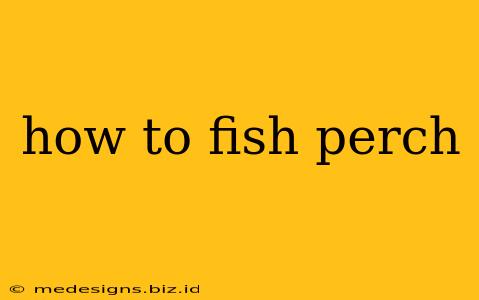Perch fishing is a rewarding experience, offering a thrilling fight and delicious fillets. Whether you're a seasoned angler or just starting, this comprehensive guide will equip you with the knowledge and techniques to successfully target these popular game fish. We'll cover everything from choosing the right gear to mastering effective fishing strategies.
Understanding Perch Behavior and Habitat
Before you even think about casting a line, understanding perch behavior is crucial. This knowledge will dramatically increase your chances of success.
Where to Find Perch:
Perch are highly adaptable fish found in a variety of freshwater habitats. They thrive in:
- Lakes and Ponds: Look for areas with submerged vegetation, rocky structures, and drop-offs. Perch often congregate near these features for cover and ambush opportunities.
- Rivers and Streams: Perch prefer slower-moving sections of rivers with plenty of cover, such as fallen logs, overhanging branches, and weed beds.
- Docks and Piers: These man-made structures provide excellent cover and attract baitfish, making them prime spots for perch.
Perch Feeding Habits:
Perch are opportunistic feeders, consuming a wide range of prey including:
- Smaller fish: This is a major part of their diet, especially for larger perch.
- Insects: Both aquatic and terrestrial insects are readily consumed.
- Crayfish: These crustaceans are a favorite food source for many perch populations.
- Worms: Earthworms and other aquatic worms are effective bait options.
Essential Gear for Perch Fishing
Having the right equipment is paramount for a successful perch fishing trip.
Rods and Reels:
- Spinning Rod: A lightweight spinning rod (6-7 feet) with a medium-light to medium action is ideal for perch fishing.
- Spinning Reel: Choose a reel with a smooth drag system and sufficient line capacity.
- Ultra-light rod: For smaller perch, an ultra-light setup offers greater sensitivity.
Line:
- Monofilament or Fluorocarbon: 6-8 pound test line is suitable for most perch fishing situations. Fluorocarbon line offers superior invisibility in the water.
Hooks:
- Small hooks: Size 6-8 hooks are generally best for perch, depending on the size of your bait.
- Sharp hooks: Ensure your hooks are razor sharp for optimal hook-up rates.
Bait and Lures:
- Live Bait: Minnows, worms, and crayfish are highly effective live baits for perch.
- Artificial Lures: Small jigs, spinners, and crankbaits in bright colors are excellent lure choices. Experiment with different colors and retrieves to find what works best.
Effective Perch Fishing Techniques
The key to successful perch fishing is understanding how to present your bait or lure in a way that entices them to strike.
Bottom Fishing:
This technique involves letting your bait or lure sink to the bottom and then slowly retrieving it. This is highly effective in areas with structure.
Jigging:
Jigging involves raising and lowering your jig or lure, mimicking the movement of a small fish. This is particularly effective in deeper water.
Trolling:
Trolling is an excellent method for covering large areas of water quickly. Use smaller lures and a slow trolling speed for the best results.
Tips for Mastering Perch Fishing
Here are some additional tips to help you maximize your success:
- Fish during the right time of day: Perch are often most active during dawn and dusk.
- Pay attention to water temperature: Perch prefer cooler water temperatures.
- Use scent attractants: Adding scent attractants to your bait or lures can increase their effectiveness.
- Practice patience: Perch fishing can be challenging at times, so patience is key.
- Respect the environment: Practice catch and release where appropriate and always dispose of your trash properly.
By following this comprehensive guide, you'll significantly increase your chances of landing a satisfying catch of perch. Remember to always check your local fishing regulations before heading out and enjoy the thrill of the chase!
